History of fountains in the United States
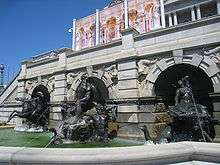
The first decorative fountain in the United States was dedicated in City Hall Park, in New York City, in 1842. Early American fountains were used to distribute clean drinking water, had little ornamentation, and copied European styles.
In the 20th century, American fountains often ceased to distribute drinking water; they became purely decorative, and were designed to honor events or individuals, as works of urban sculpture or to imitate nature. In the late 20th century, the musical fountain, where the dance of water is controlled by a computer and is accompanied by lights and music, became a form of public entertainment in Las Vegas and other American cities.
1800-1900
Philadelphia built the first citywide water system in the United States, which began operation in January 1801. Underground aqueducts carried drinking water from the Schuylkill River, and twin steam pumps propelled it into a water tower at Centre Square, now the site of Philadelphia City Hall. Scottish-born architect Benjamin Henry Latrobe designed the system along with the Greek Revival pumping house/water tower.[1] Centre Square was converted from a meadow into a public park, and an ornamental fountain was added, 1808–1809. Sculptor William Rush carved a wooden statue, Allegory of the Schuylkill River (better known as Water Nymph with Bittern), to adorn the Centre Square fountain.[2]
The first monumental fountains in the United States were built to mark the termini of aqueducts bringing fresh drinking water into New York City. A cholera epidemic in 1832 and the disastrous Great Fire of New York, in 1835, persuaded the government of New York City to build the Croton aqueduct to bring abundant fresh water into the city. The Croton Dam, aqueduct, and reservoir were finished in 1841, bringing water 40 miles from the Croton River to New York City. In commemoration, the first fountain in the U.S., the Croton Fountain in City Hall Park, was turned on on October 14, 1842 and jetted water 50 feet into the air.[3] A second fountain in Union Square was also connected to the system.
The first fountains were very simple, without sculpture, and simply spouted water up into the air. They no longer exist, though vestiges of the original water system remain.[4]
In 1848, Boston completed its own new water system, an aqueduct from Lake Cochituate 20 miles (32 km) to the Boston Common, where the first fountain was located. A parade and festival were held to mark the fountain's opening on October 25, 1848. The ceremony included schoolchildren singing an ode written by American poet James Russell Lowell for the event. The ode began:
"My name is Water: I have sped through strange dark ways untried before, By pure desire of friendship led, Cochituate's Ambassador: He sends four gifts by me, Long life, health, peace, and purity."[5]
In contrast to the first American fountains, which were simple and functional, in the 1850s, more decorative fountains were constructed as part of a nationwide effort to beautify American cities by building parks, squares, and fountains inspired by European models.

For example, the Bethesda Fountain was created to adorn New York City's new Central Park, which project had been begun in 1858 by Frederick Law Olmsted and Calvert Vaux, to create a vast natural landscape in the heart of the city. In the middle of the park was one formal element: a mall adorned with elm trees and a terrace with views over a lake. In 1863, the park commissioners decided to build a monumental fountain for the central basin in the middle of the mall. The sculptor was a little-known American artist, Emma Stebbins, whose brother was the head of the New York Stock Exchange and President of the Board of Commissioners, who lobbied on her behalf. Her fountain was based on the biblical verse from the Gospel of Saint John, in which an angel touched, or "troubled", the waters of the Pool of Bethesda in Jerusalem, giving it healing powers. She wrote about the fountain: "We have no less healing, comfort and purification freely sent to us through the blessed gift of pure, wholesome water, which to all the countless homes of this great city comes like an angel visitant."[6] It was criticized by some writers when it was opened in 1873: the New York Times called it "a feebly-pretty idealess thing",[7] but gradually the fountain became a popular favorite, featured in many films and in recent times in Tony Kushner's play Angels in America.[8]
1900-2000
Fountains built in the United States between 1900 and 1950 mostly followed European models and classical styles. For example:
- The handsome Samuel Francis Dupont Memorial Fountain (aka Dupont Circle Fountain), in Dupont Circle, Washington D.C., was designed and created by Henry Bacon and Daniel Chester French, the architect and sculptor of the Lincoln Memorial, in 1921, in a pure neoclassical style.
- The Buckingham Fountain in Grant Park, Chicago was one of the first American fountains to use powerful modern pumps to shoot water as high as 150 feet (46 meters) into the air.
- The Fountain of Prometheus, with sculpture by Paul Manship, built at Rockefeller Center in New York City in 1933, was the first American fountain in the Art-Deco style.
After World War II, fountains in the United States became more varied in form. Some, like the Vaillancourt Fountain in San Francisco (1971), were pure works of sculpture. The modernist French-Canadian Armand Vaillancourt built his monumental fountain at Embarcadero Plaza in San Francisco in a cubist style, though it was intended as a political statement - the official title is "Quebec Libre!", and the artist was arrested at the time of the opening for painting political slogans on his own fountain.
Other fountains, like the Frankin Roosevelt Memorial Waterfall (1997), by architect Lawrence Halprin, were designed as landscapes to illustrate themes. This fountain is part of the Franklin Delano Roosevelt Memorial in Washington D.C., which has four outdoor "rooms" illustrating FDR's Presidency. Each "room" contains a cascade or waterfall; the cascade in the third room illustrates the turbulence of the years of the World War II. Halprin wrote at an early stage of the design; "the whole environment of the memorial becomes sculpture: to touch, feel, hear and contact - with all the senses."[9]
One of the most unusual modern American fountains is the Civil Rights Memorial (1989) at the Southern Poverty Law Center in Montgomery, Alabama, designed by Maya Lin, the designer of the Vietnam Veterans Memorial in Washington D.C. The Civil Rights Memorial fountain features a low elliptical black granite table, with a thin surface of water flowing over the surface, over the inscribed names of civil rights leaders who lost their lives, illustrating the quotation from Martin Luther King Jr.: "...Until justice rolls down like waters and righteousness like a mighty stream." Visitors are invited to touch the names through the water. "The water is as slow as I could get it," Lin wrote. "It remains very still until you touch it. Your hand carves ripples, which transform and alter the piece, just as reading the words completes the piece."[10]
Significant fountains in the United States
- See also Drinking fountains in the United States.
| Name | Image | Location | Architect(s) | Sculptor(s) | Year completed | Notes |
|---|---|---|---|---|---|---|
| Bartholdi Fountain Fountain of Light and Water |
.jpg) |
United States Botanical Gardens, Washington, D.C. |
Frédéric Auguste Bartholdi | Philadelphia, 1876 Washington, D.C., 1878 |
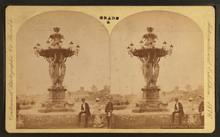 First fountain in the United States illuminated by gaslight. | |
| Bethesda Fountain |  |
Central Park, Manhattan, New York City |
Calvert Vaux | Emma Stebbins | 1873 | Memorial to soldiers killed and wounded in the American Civil War. |
| Buckingham Fountain |  |
Chicago, Illinois | Edward H. Bennett | Marcel F. Loyau | 1927 |  |
| Centennial Fountain Nicholas J. Melas Centennial Fountain |
 |
Chicago, Illinois | Lohan Associates | 1989 |  | |
| Civil Rights Memorial |  |
Montgomery, Alabama | Maya Lin | 1989 |  | |
| Coleman Memorial Fountain |  |
Sacramento, California | Ralph Stackpole | 1927 | ||
| Columbus Fountain Christopher Columbus Memorial Fountain |
Union Station, Washington, D.C. |
Daniel Burnham | Lorado Taft | 1912 | .jpg) | |
| Corning Fountain | Bushnell Park, Hartford, Connecticut |
J. Massey Rhind | 1899 | |||
| Court of Neptune Fountain |  |
Thomas Jefferson Building, Library of Congress, Washington, D.C. |
John L. Smithmeyer Paul J. Pelz Edward Pearce Casey |
Roland Hinton Perry Albert Weinert (relief sculpture) |
1895 |  |
| Depew Memorial Fountain |  |
Indianapolis, Indiana | Henry Bacon | Karl Bitter Alexander Stirling Calder |
1919 | 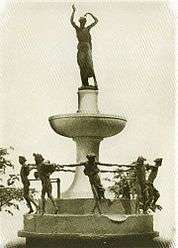 Following Bitter's 1915 death, Calder completed the sculpture work. |
| Donahue Memorial Fountain The Mechanics Monument |
San Francisco, California | Willis Polk | Douglas Tilden | 1901 | _-_NARA_-_524405.tif.jpg) | |
| Dupont Circle Fountain Rear Admiral Samuel Francis Dupont Memorial Fountain |
Dupont Circle, Washington, D.C. |
Henry Bacon | Daniel Chester French | 1921 |  | |
| Fort Worth Water Gardens |  |
Fort Worth, Texas | Philip Johnson John Burgee |
1974 |  | |
| Fountain of Eternal Life War Memorial Fountain |
Cleveland, Ohio | Marshall Fredericks | 1964 | |||
| Fountain of the Centaurs and The Signing of the Treaty |  |
Jefferson City, Missouri | Karl Bitter and A.A. Weinman | 1927 | ||
| Fountain of the Great Lakes | 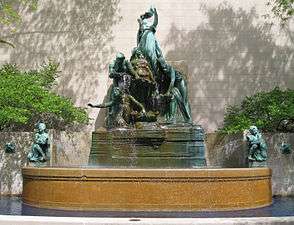 |
Art Institute of Chicago Garden, Chicago, Illinois |
Lorado Taft | 1913 | ||
| Fountain Hills Fountain |  |
Fountain Lake, Fountain Hills, Arizona |
1970 | World's tallest fountain when built, the jet shoots up 562 feet (171 m). Now world's fourth-tallest fountain, and second-tallest in the United States. | ||
| Fountain of the Rings |  |
Centennial Olympic Park, Atlanta, Georgia |
EDAW, Inc. William Hobbs, Ltd. |
1996 | 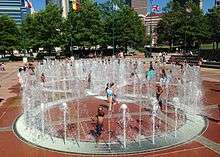 | |
| Fountain of Time |  |
Chicago, Illinois | Lorado Taft | 1922 |  | |
| Fountains of Bellagio | Bellagio Resort, Las Vegas, Nevada |
WET (Water Entertainment Technologies) | 1998 |  | ||
| Gateway Geyser | 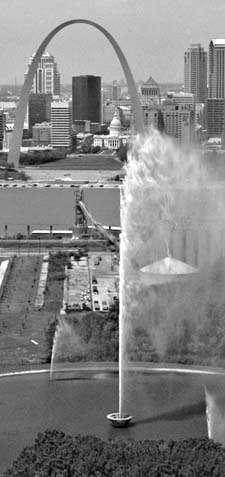 |
Malcolm W. Martin Memorial Park, East St. Louis, Illinois |
1995 | Located on the opposite side of the Mississippi River from the Gateway Arch, its jet can shoot up 630 ft (192 m), the same height as the arch. | ||
| LaFayette Fountain | 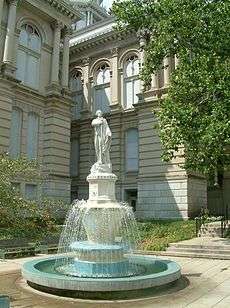 |
Lafayette, Indiana | Lorado Taft | 1882 | This was the first of Taft's many fountains. | |
| Littlefield Fountain | University of Texas at Austin, Austin, Texas |
Morison & Walker Paul Cret |
Pompeo Coppini Amanda Waldine Tauch |
1933 | ||
| Longwood Gardens | .jpg) |
Kennett Square, Pennsylvania | Open Air Theatre, 1914 Italian Water Garden, 1927 Main Fountain Garden, 1931 |
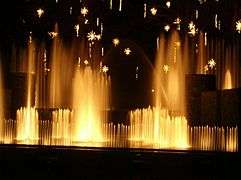 | ||
| Meeting of the Waters Fountain[11] The Wedding of the Waters |
.jpg) |
Aloe Plaza, Saint Louis, Missouri |
Carl Milles | 1940 | Detail. | |
| National World War II Memorial | National Mall, Washington, D.C. |
Friedrich St. Florian | Raymond Kaskey James Peniston |
2004 |  | |
| Jesse Clyde Nichols Memorial Fountain | Country Club Plaza, Kansas City, Missouri |
McKim, Mead & White | Henri-Léon Gréber | 1910 1960 |
The fountain was created for "Harbor Hill," the Clarence Mackay estate in Roslyn, New York. Four larger-than-life equestrian figures represent great rivers: "The Rhine," "The Seine," "The Volga," and "The Mississippi." It was disassembled, transported, and installed in Kansas City in 1960. | |
| Piazza d'Italia |  |
New Orleans, Louisiana | Charles Williard Moore Perez Architects |
1978 |  | |
| Prometheus Fountain |  |
Rockefeller Center, Manhattan, New York City |
Raymond Hood | Paul Manship | 1933 | .jpg) |
| Pulitzer Fountain | Grand Army Plaza, 5th Avenue & Central Park South, Manhattan, New York City |
Thomas Hastings | Karl Bitter Isidore Konti Karl Gruppe |
1916 | Following Bitter's 1915 death, Konti and Gruppe completed the sculpture work. | |
| Rackham Memorial Fountain |  |
Detroit Zoo, Royal Oak, Michigan |
Corrado Parducci | 1939 |  | |
| Franklin Delano Roosevelt Memorial | 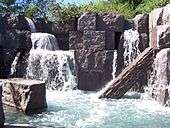 |
West Potomac Park, Washington, D.C. |
Lawrence Halprin | 1997 | ||
| Russell Ager Memorial Fountain | _in_Detroit%2C_Michigan.jpeg) |
Detroit, Michigan | Henry Bacon | Daniel Chester French | 1921 | |
| The Sciences and The Arts Fountains |  |
Jefferson City, Missouri | Robert Ingersoll Aitken | 1924 | ||
| Scott Memorial Fountain | Belle Isle Park, Detroit, Michigan |
Cass Gilbert | Herbert Adams | 1925 | .jpg) | |
| Soldiers' and Sailors' Monument | 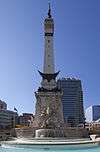 |
Indianapolis, Indiana | Bruno Schmitz | Rudolf Schwarz Frederick MacMonnies George Brewster Nicholas Geiger |
1888 |  |
| Swann Memorial Fountain Fountain of the Three Rivers |
 |
Logan Circle, Philadelphia, Pennsylvania |
Wilson Eyre | Alexander Stirling Calder | 1924 |  |
| Thatcher Memorial Fountain[12] |  |
City Park, Denver, Colorado |
J.R.M. Morrison | Lorado Taft | 1918 | |
| Tyler Davidson Fountain |  |
Fountain Square, Cincinnati, Ohio |
August von Kreling Ferdinand von Miller Fritz von Miller Ferdinand Freiherr von Miller |
1871 |  The fountain was designed by August von Kreling in the 1840s for King Ludwig of Bavaria, but never built. It was cast in Germany in 1870, and shipped to the United States.[13] | |
| Unisphere | 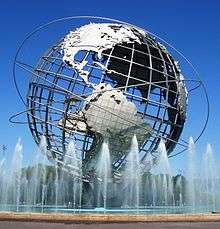 |
Flushing Meadows Park, Queens, New York City |
Gilmore D. Clarke | 1964 |  | |
| Vaillancourt Fountain "Quebec Libre!" |
Justin Herman Plaza, San Francisco, California |
Armand Vaillancourt | 1971 | |||
See also
Bibliography
| Wikimedia Commons has media related to Fountains in the United States. |
- Marilyn Symmes (editor), Fountains-Splash and Spectacle- Water and Design from the Renaissance to the Present. Thames and Hudson, in cooperation with the Cooper-Hewitt National Design Museum of the Smithsonian Institution. (1998).
Sources and Citations
- ↑ "Benjamin Latrobe Designs the first American Steam-Powered Municipal Waterworks," from This Week in History, January 2012, The Schiller Institute.
- ↑ Head of the Nymph, from Pennsylvania Academy of the Fine Arts.
- ↑ Ric Burns and James Sanders, New York, an Illustrated History, Alfred Knopf, New York, 1999, pg. 78-79.
- ↑ Marilyn Symmes with Maria Ann Conelli, "Fountains as Refreshment", in the collection Fountains- Splash and Spectacle, Water and Design from the Renaissance to the Present. Thames and Hudson, London, 1998.
- ↑ Quoted by Marilynn Symmes and Maria Ann Conelli in Fountains, Splash and Spectacle. Pg. 45.
- ↑ Charlotte Streifer Rubinstein, 'American Women Sculptors: A History of Women Working in Three Dimensions, Chicago, 1990, pg. 63-66. Cited in "The Bethesda Fountain in New York City", article by Andrew Scott Dolkart in Fountains- Splash and Spectacle, Water and Design from the Renaissance to the Present, by Marilynn Symmes.
- ↑ "The Bethesda Fountain", The New York Times, June 1, 1873.
- ↑ Tony Kushner - Angels in America part two, Perestroika, New York, 1994, pp. 143-146. Cited by Andrew Scott Dolkart in Fountains - Splash and Spectacle.
- ↑ Halprin, Lawrence, Notebooks 1959-1971, Cambridge Massachusetts (1972)
- ↑ Zinnser, William, "I Realized Her Tears Were Becoming Part of The Memorial (Maya Lin), Smithsonian 22, no. 6. September 1991 pp. 32-43.
- ↑ Meeting of the Waters Fountain, from City of St. Louis.
- ↑ Thatcher Memorial Fountain from Public Art Archive.
- ↑ Tyler Davidson Fountain, from SIRIS.